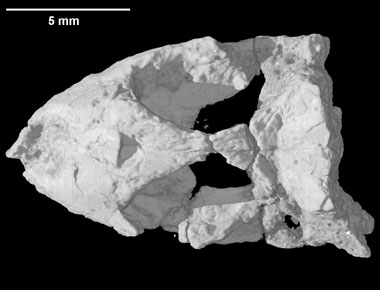This page serves supplemental imagery for a paper entitled Gobekko cretacicus (Reptilia: Squamata) and its bearing on the interpretation of gekkotan affinities, by J.D. Daza, A.M. Bauer and E. Snively (2013, Zoological Journal of the Linnean Society, 167, 430-448). The abstract is as follows:
Gobekko cretacicus, a Cretaceous lizard from the Gobi Desert of Mongolia, is a key fossil for understanding gecko phylogeny. We revisit this fossil using high-resolution X-ray computed tomography. The application of this imaging method reveals new information about sutures, bone shape, and structural details of the palate and basicranium. These data were used to assess the phylogenetic affinities of Gobekko in the context of an existing squamate data set. The effects of character ordering, search strategy, and the addition of another putative gekkonomorph (Hoburogekko suchanovi) on inferred gekkonomorph relationships were explored. Available specimens of G. cretacicus are skeletally mature but have unfused nasals, frontals, and parietals, and (possibly) a persistent basicranial fenestra. Some putative gekkonomorphs are not consistently supported as closer to crown clade gekkotans than to autarchoglossans. In a strict consensus both Gobekko and Hoburogekko form a polytomy with extant geckos. Some of the adult character states of Gobekko are observable in embryos of extant species. The evolution of tubular frontals and dentaries in gekkotans may be structurally related to the loss of the postorbital and supratemporal bars in this lineage. The complete lack of a parietal foramen, and presumably a light-sensitive parietal eye, in this clade is of interest and could indicate an early origin of nocturnality in geckos.

About the Species
This specimen was made available to the University of Texas High-Resolution X-ray CT Facility for scanning by Dr. Aaron Bauer of Villanova University. Funding was provided by an NSF grant to Dr. Bauer (DEB-0515909).

About this Specimen
This specimen was scanned by Matthew Colbert on 23 October 2007 along the coronal axis for a total of 708 slices. Each 1024 x 1024 pixel slice is 0.02086 mm thick, with an interslice spacing 0.02086 mm and a field of reconstruction of 9.9 mm.

About the
Scan
Literature
& Links
None available.

Additional
Imagery
|



 ,
, 



